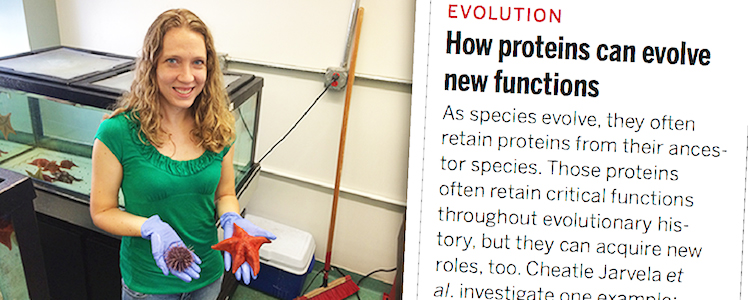Friday, August 15, 2014

Hinman Lab Shows How Proteins Can Evolve New Functions
Fresh off a highlight in Science, the Hinman lab is excited to share their recent research with a larger scientific community. Originally published in Molecular Biology and Evolution, “Modular Evolution of DNA Binding Preference of a Tbrain Transcription Factor Provides a Mechanism for Modifying Gene Regulatory Networks” marks new findings in the way DNA-bound proteins can evolve and acquire new roles. This research is the result of interdisciplinary collaboration between members of the Hinman lab from the Department of Biological Sciences (Alys Cheatle Jarvela, Lisa Brubaker, and Veronica Hinman), the Armitage lab from the Department of Chemistry (Anisha Gupta and Bruce Armitage), and the Bulyk lab at Harvard Medical School (Anastasia Vedenko and Martha Bulyk).
In all animals on Earth, variations in body plan (including symmetry, numbers and types of limbs, etc.) arise during development from differences in the genetic processes that serve as a blueprint for development. Therefore, to understand animal diversity it is important to study the evolution of developmental mechanisms. Researchers in the field of Evolution and Development, or Evo-Devo, have long believed that differences in animal morphology are the product of changes to regulatory DNA. Once thought to be “junk DNA”, these genomic regions actually contain directions for proper temporal and spatial deployment of genes. Each gene will frequently have a separate regulatory module for each of its temporal and spatial expression domains, and so these can easily be tweaked without altering multiple gene functions.
On the other hand, transcription factors, which are proteins that read these regulatory DNA regions and execute the directions within, have been believed to be less suited to evolve. A small set of transcription factors are used to bind a multitude of different regulatory DNAs in a wide variety of contexts. Changes to these proteins will have drastic effects on how an organism develops, and are extremely likely to kill the developing embryo. Recently, some aspects of transcription factor function, such as interactions with other proteins, have been shown to be able to evolve. However, the way in which transcription factors recognize and bind DNA sequences is still thought to be quite impervious to change.
Work from the Hinman lab now shows that transcription factors can evolve differences in DNA-binding between closely related organisms. By studying the binding properties of a Tbr transcription factor from two echinoderms (sea stars and sea urchins), Cheatle Jarvela and colleagues demonstrated that binding to a highly favored, or primary DNA binding site, does remain strongly conserved over the course of evolution. But while the primary binding site is not likely to change, the next preferred, or secondary DNA binding site can change. In the sea star embryo, Tbr is able to use both types of binding site, but prefers the primary over the secondary when protein levels are low, suggesting an ability to use these sites for separate developmental functions. This work shows that use of multiple binding sites is important to reduce the negative impact of evolving changes to a transcription factor. Therefore, both regulatory DNA and the transcription factors that bind to them both can contribute to the evolution of animal form.